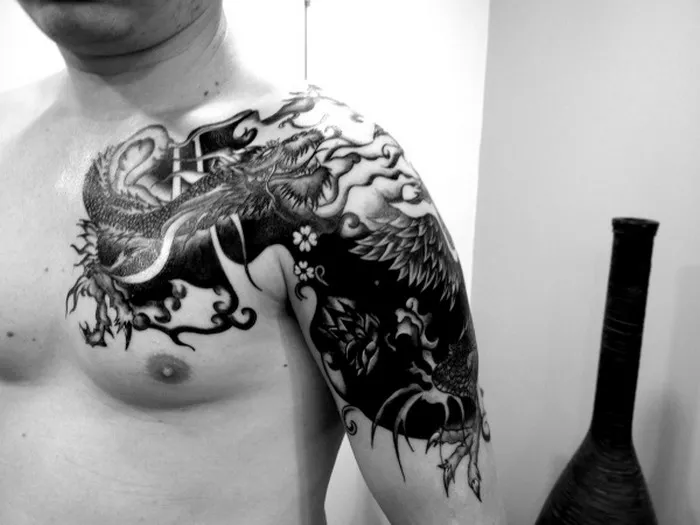Asian dragon tattoos have long captured the imagination, serving as powerful symbols in various cultures across Asia. Known for their majestic appearance and deep-rooted meanings, these tattoos are a popular choice for sleeve designs. In this comprehensive guide, we’ll explore the rich history and symbolism of Asian dragon tattoos, various design styles, placement considerations, and tips for choosing the right artist. Whether you’re contemplating your first tattoo or adding to your collection, this article will provide you with all the information you need.
The Symbolism of Asian Dragons
1. Cultural Significance
Asian dragons are vastly different from their Western counterparts. While Western dragons are often depicted as destructive creatures, Asian dragons are revered as benevolent beings. In cultures such as Chinese, Japanese, and Korean, they symbolize:
Power and Strength: Dragons are often associated with emperors and kings, representing authority and dominance.
Wisdom and Knowledge: In many myths, dragons are portrayed as wise creatures that hold ancient knowledge.
Good Fortune and Prosperity: Dragons are seen as harbingers of good luck, particularly in Chinese culture, where they are believed to bring wealth and success.
2. Elemental Associations
Asian dragons are often linked to specific elements, further enhancing their meanings:
Water: Many Asian dragons are depicted as water deities, associated with rain, rivers, and seas.
Fire: Some dragons embody the fire element, representing transformation and passion.
Earth: Dragons associated with earth symbolize stability and grounding forces.
Styles of Asian Dragon Tattoo Sleeves
1. Traditional Chinese Dragon Tattoos
Features
Design Elements: Characterized by flowing, serpentine bodies and long, clawed limbs. Traditional Chinese dragons often have antler-like horns and are surrounded by clouds or waves.
Color Palette: Vivid colors such as red, green, and gold are common, symbolizing various meanings, like prosperity and good luck.
Symbolism
Chinese Zodiac: The dragon is one of the twelve animals in the Chinese zodiac, symbolizing those born under its sign as ambitious and charismatic.
2. Japanese Dragon Tattoos
Features
Design Elements: Japanese dragons typically have three claws (unlike Chinese dragons, which usually have five) and are often depicted in dynamic poses, symbolizing motion and power.
Cultural Motifs: Japanese dragons are frequently integrated into larger tattoo compositions that include cherry blossoms, waves, or koi fish, enhancing the overall design.
Symbolism
Protectors: In Japanese mythology, dragons are seen as protectors, often guarding treasures or sacred places.
3. Korean Dragon Tattoos
Features
Design Elements: Korean dragons are often depicted with a more robust build and less elongated bodies compared to their Chinese and Japanese counterparts. They may also feature a distinct mane.
Elemental Connection: Frequently associated with rain and agriculture, Korean dragons embody fertility and abundance.
Symbolism
Royalty: Historically, Korean dragons are linked to royalty and governance, symbolizing strength and nobility.
Designing Your Asian Dragon Tattoo Sleeve
1. Choosing the Right Design
When selecting a design for your sleeve, consider the following:
Personal Significance: Choose a design that resonates with your values, experiences, or aspirations.
Style Preference: Decide whether you prefer a traditional look or a more modern interpretation. Research different artists’ styles to find one that matches your vision.
2. Placement Considerations
Sleeves can vary in size and complexity. When planning your sleeve, think about:
Full Sleeve vs. Half Sleeve: A full sleeve wraps around the arm completely, while a half sleeve covers only a portion.
Integration with Other Tattoos: If you already have tattoos, consider how your dragon design will complement them.
3. Color vs. Black and Grey
Decide whether you want your tattoo to be colorful or done in black and grey. Colorful tattoos often pop and draw attention, while black and grey tattoos can have a more timeless and classic feel.
Finding the Right Tattoo Artist
1. Researching Artists
Not all tattoo artists specialize in Asian dragon designs. When searching for the right artist, consider:
Portfolio: Review their previous work to assess their style and expertise in Asian dragon tattoos.
Experience: Look for artists who have experience with sleeve tattoos and have received positive reviews from clients.
2. Consultation
Before committing to a design, schedule a consultation to discuss your ideas. An experienced artist will help you refine your concept and provide insights into what will work best for your body and style.
Care and Maintenance of Your Tattoo
1. Aftercare
Proper aftercare is crucial for the healing process and longevity of your tattoo. Follow these steps:
Keep it Clean: Gently wash the tattoo with mild soap and water.
Moisturize: Use a fragrance-free moisturizer or tattoo aftercare product to keep the area hydrated.
Avoid Sun Exposure: Protect your tattoo from direct sunlight during the healing process to prevent fading.
2. Long-Term Care
To maintain the vibrancy of your tattoo over time:
Use Sunscreen: Apply sunscreen to your tattoo when exposed to sunlight.
Stay Hydrated: Keeping your skin hydrated can help preserve the appearance of your tattoo.
Conclusion
An Asian dragon tattoo sleeve is a stunning and meaningful choice that embodies power, wisdom, and good fortune. With a rich history and deep symbolism, these tattoos can serve as personal expressions of identity and culture. Whether you opt for a traditional design or a modern interpretation, taking the time to research and plan your tattoo will ensure a rewarding experience. By choosing the right artist and properly caring for your tattoo, you can enjoy a beautiful piece of art that tells a story for years to come. As you embark on this journey, remember that your tattoo is not just an aesthetic choice; it’s a reflection of your beliefs, experiences, and aspirations.
Related topics:

